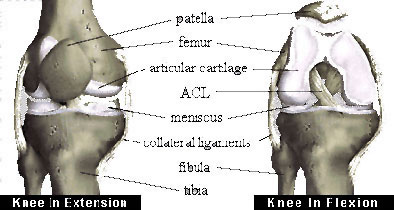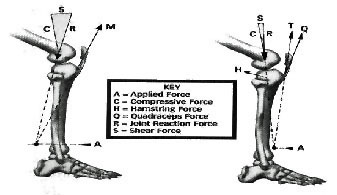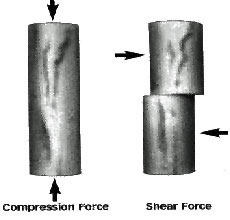

A Review of Open and Closed Kinetic Chain Exercise
Following Anterior Cruciate Ligament Reconstruction
By Anthony C. Miller
The following article has been reproduced by the author, Tony Miller, by kind permission. The article is an abstract on a review of open and closed kinetic chain exercise following anterior cruciate ligament reconstruction that formed part of his submitted thesis for his Master's degree. Tony studied at the Midwestern State University, completing his Master of Science in Kinesiology in 1999. As a graduate student, he was able to study under Dr Lon Kilgore, one of the USA's most respected strength coaches.
Abstract
Over the past ten years, there has been a steady argument from physicians, therapists, and coaches over which form of kinetic exercise is most beneficial following anterior cruciate ligament (5) (ACL) reconstruction (Fig. 1).
| Figure 1 - Anatomy of the Knee |
 |
Some therapists agree that open kinetic chain exercise (OKCE) best benefits ACL. In contrast, some therapists believe that closed kinetic chain exercises (CKCE) are superior to OKCE. Recently, ACL ruptures have become the most common knee injury in the world of sports. There are approximately 250,000 ACL injuries in a given year (2). These injuries occur due to shear force placed on the ligament during decelerating, turning, planting and cutting, and different landings. The ACL can only withstand 400 pounds of pressure at any given time. Injuries become more common in high-impact sports (10). With injuries becoming more frequent, rehabilitation is becoming more critical. This review aimed to determine which form of kinetic chain exercise, open or closed, is most beneficial following ACL reconstruction. We analyzed the most crucial areas during rehabilitation, strain, stability, joint force, range of motion (ROM), and strength. We believe that following ACL reconstruction, the safest Kinetic Chain Exercise will decrease stress, strain, and an increased instability as well as a range of motion (11).
Kinetic Chain Exercises
Two types of Kinetic Chain Exercises are used during any exercise regimen, whether for rehabilitation or strengthening. The first is Open Kinetic Chain Exercises (OKCE). These exercises are performed typically where the foot is free to move. These exercises are generally non-weight bearing, with the movement occurring at the knee joint (4). If there is any weight applied, it is applied to the limb's distal portion. Examples of these exercises would be knee extensions and straight leg raises. OKCE concentrates on a solid quadriceps contraction, strengthening the quadriceps and restoring quadricep power output (8).
The second exercise used is the Closed Kinetic Chain Exercise (CKCE). CKCE is performed where the foot is fixed and cannot move. The foot remains in constant contact with the surface, usually the ground or the base of a machine (8). These are typically weight-bearing exercises, where an athlete or patient uses their body and external weight. When external weight is added, it is usually rested across the back of the shoulders or the front of the chest. Examples of these exercises would be the Squat (both front and back), Leg Press, Lung, Power Clean, and Snatch. CKCE concentrates on a co-contraction of the quadriceps, hamstrings, hip flexors, soleus, and gastrocnemius muscles (9). This is also a multi-joint movement, which focuses on the knee, hip, and ankle. CKCE are labelled as being "sport-specific movements" (11).
External Forces
During Kinetic Exercises, there are typically two kinds of external forces: shear and compression. Figures 2 and 3 give examples of each type of force. Figure 2 shows the angles of the shear force placed on the knee joint during OKCE and CKCE. Figure 3 shows the ACL with shear and compression forces placed upon it (6).
| Figure 2 - Shear force during kinetic exercises |
 |
Shear force is the force which disrupts the ACL by shifting the tibia anteriorly and the femur posteriorly. This force, placed on the front of the knee, places a large amount of stress on the ACL. This is caused by the muscular contraction of the quadriceps, which is typical of the Open Chain Exercise.
The compression force is caused by a strong external force placed on the knee, which pushes the head of the femur together with the head of the tibia. This external force causes stability in the knee and a decrease in shear force. Compression forces are common in Closed Chain Exercises (3, 6).
Review of Literature
Following ACL reconstruction, rehabilitation is the most critical aspect of restoring the knee joint to normal competition levels. Over the past decade, several studies have focused on ACL rehabilitation (5). Due to the extensive research in this field, there are still differences in opinions among many people involved in the athletic community (11).
Koch (6), in a magazine essay, states CKCE produces a minimal amount of shear force while OKCE has a significant amount of shear force. When the knee is extended during Kinetic Chain Exercises, there is a muscular contraction of the quadriceps. Koch found that with CKCE, there is a co-contraction of the quadriceps and hamstrings (6). This reduces the shear force placed on the knee by stabilizing the knee joint. It is opposing OKCE, which increases the shear force on the knee joint. This is caused by the anterior lower leg shifting, which places significant stress on the ACL (Fig. 2 & 3).
| Figure 3 - Joint Forces |
 |
Previous research comparing OKCE, and CKCE found that CKCE was a safer and more beneficial form of exercise. Pincivero et al. (12) found that CKCE reduced the shear force and increased compression force in the knee joint (Fig. 3). Also, they discovered that CKCE activated the hamstrings, which increases knee stability. This occurs because, with the hamstrings' contraction, the quadriceps are neutralized by pulling the tibia forward, decreasing anterior tibial displacement (3).
Escamilla et al. (3) found a large amount of quadriceps activity during both exercises (quadricep contraction causes anterior tibial displacement). They found that strain placed on the ACL during exercise is directly related to the sheer force placed on the knee joint (3). When sheer force decreases, this leads to a decrease in anterior tibial displacement. During CKCE the hamstrings are contracted, which reduces anterior tibial displacement. This study found that OKCE increases the anterior displacement of the tibia. Also, the sheer force is increased with OKCE. These results are similar to Jenkins et al.'s study (5).
In 1997 Fitzgerald (4) found no significant differences between OKCE and CKCE. In this study, Fitzgerald believes there is a place for both kinetic exercises during ACL rehabilitation.
Conclusion
Rehabilitation is the most crucial stage following ACL rupture. It is vital to understand what each form of kinetic exercise does to the knee joint (1). As coaches, trainers, physicians, and therapists, we must understand the strain, joint forces (Fig. 3), and torque placed on the knee during each exercise. Also, we must acknowledge which exercises cause stability, an increase in compression force, and increased ROM, which will benefit the patient during rehabilitation.
The most important aspect is to return the athlete to the pre-injury competition level as safe as possible (11). To do this, we must utilize the exercises that prevent re-injuring the repaired ACL. This literature review found that Closed Kinetic Chain Exercises are the most beneficial during the rehabilitation of the repaired ACL. Also, CKCE is the most helpful exercise used to prevent future knee joint injuries (5, 6, 7).
Recommendations
We believe that there needs to be more research which focuses mainly on comparing OKCE and CKCE. Of the studies found, only one study supported OKCE, and the only one noticed no significant differences between OKCE and CKCE. The rest of the studies concentrated on the advantages and disadvantages of either Kinetic Chain Exercise or the other. There were only a few articles which compared directly Open and Closed Kinetic Chain Exercises.
References
- Figure 1. Aichroth PM, Cannon WD, Amis AA, Mahadevan V, Bull AJ, & Harris JM. "The Interactive Knee." Primal Pictures, Ltd. 1998
- Figures 2 & 3. Koch, A. Leg extensions: are they destroying your knees. Muscular Development: 100-103, June 1999
- Jenkins, et al. A measurement of anterior tibial displacement in closed and open kinetic chain. JOSPT, 25(1): 49-56, 1997
- Clasby, L & Young MA. Management of sports-related anterior cruciate ligament injuries. AORN
- Russell, et al. Knee muscle strength in elite male gymnasts. JOSPT, 22(1): 10-17, 1995.
- Shelbourne, KD & Nitz, P. Accelerated rehabilitation after anterior cruciate ligament reconstruction. The American Journal of Sports Medicine, 18(3): 292-299, 1990
- Escamilla, et al. Biomechanics of the knee during closed kinetic chain and open kinetic chain exercises. Medicine and Science in Sports and Exercise Science: 556-569, 1998
- Koch, A. Leg extensions: are they destroying your knees. Muscular Development: 100-103, June 1999.
- Palmitier, et al. Kinetic chain exercises in knee rehabilitation. Sports Medicine, 11(6): 402-413, 1991
- Anderson, AF & Lipscomb AB. Analysis of rehabilitation techniques after anterior cruciate reconstruction. The American Journal of Sports Medicine, 17(2): 154-160, 1989.
- Fitzgerald, GK. Open versus closed chain kinetic exercise: issues in rehabilitation after anterior cruciate ligament reconstructive surgery. Physical Therapy, 77(12): 1747-1754, 1997.
- Nisell, R. Mechanics of the Knee: a study of joint and muscle load with clinical applications. ACTA Orthopaedic Scandinavica Supplementum, 216(56): 1-42, 1985.
- Lander, et al. Biomechanics of the squat exercise using a modified center of mass bar. Medicine and Science in Sports and Exercise: 469-478, March 1986
- Pincivero, et al. Relation between open and closed kinematic chain assessment of knee strength and functional performance. Clinical Journal of Sports Medicine, 7: 11-16, 1997.
Page Reference
If you quote information from this page in your work, then the reference for this page is:
- MACKENZIE, B. (2000) A Review of Open and Closed Kinetic Chain Exercise Following Anterior Cruciate Ligament Reconstruction [WWW] Available from: https://www.brianmac.co.uk/kneeinj.htm [Accessed